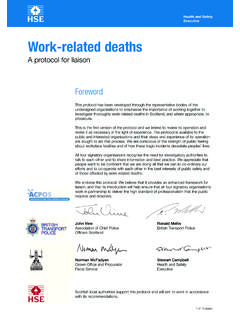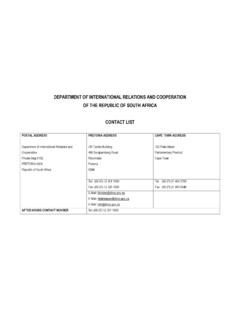Transcription of Work-related Deaths: A protocol for liaison (England and ...
1 Work-related Deaths: A protocol for liaison (England and Wales). Foreword This is the fourth version of this protocol , which was first introduced in 1998. The signatories to the protocol are: National Police Chiefs' Council (NPCC);. British Transport Police (BTP);. Care Quality Commission (CQC);. Care and Social Services Inspectorate Wales (CSSIW);. Chief Fire Officers' Association (CFOA);. Crown Prosecution Service (CPS);. Health and Safety Executive (HSE);. Healthcare Inspectorate Wales (HIW);. Local Government Association (LGA);. Maritime and Coastguard Agency (MCA);. Medicines and Healthcare products Regulatory Authority: Medical Devices Division;. Office for Nuclear Regulation (ONR);. Office of Rail and Road (ORR);. Welsh Local Government Association. Other enforcing authorities, investigators and regulators who are not signatories to this protocol but agree to abide by the protocol 's principles include the Civil Aviation Authority (CAA) and the Independent Police Complaints Commission (IPCC).
2 The protocol is a high level document which is supported by, and should be read in conjunction with the Work-related Deaths protocol Practical Guide which sets out a straightforward step-by-step approach to the joint investigation of Work-related deaths. The purpose of the protocol and supporting guide is to ensure effective joint investigation of Work-related deaths in England and Wales. Since its introduction in 1998, the protocol has become a tried and tested approach to effective liaison between the signatory organisations when investigating a Work-related death. By signing the protocol , signatories confirm their commitment to the joint investigation approach, appreciating that the public want to be confident that those investigating Work-related deaths are doing all that they can to co-ordinate activities, and to co- operate with each other in the best interests of public safety and of those affected by Work-related deaths. Annex A provides a general guide to the enforcement of the Homicide related offences, the Health and Safety at Work etc.
3 Act 1974 (HSW Act) and related legislation. 2. Signatories Commander Dean Hayden Metropolitan Police Service National Police Chiefs' Council Paul Crowther Chief Constable British Transport Police Paul Hancock President Chief Fire Officers Association Alison Saunders Director of Public Prosecutions Crown Prosecution Service David Behan Chief Executive The Care Quality Commission Imelda Richardson Chief Executive Care and Social Services Inspectorate Wales Richard Judge Chief Executive Health and Safety Executive Kate Chamberlain Chief Executive Healthcare Inspectorate Wales Nick Worth Regulatory Services Champion The Local Government Association Alan Massey Chief Executive Maritime and Coastguard Agency John Wilkinson Director MHRA Medical Devices Division Richard Savage Chief Inspector Office for Nuclear Regulation Richard Price Chief Executive Office of Rail and Road Neil Moore Spokesperson for Regeneration, Economic Development and Regulatory Services The Welsh Local Government Association 3.
4 1 Statement of intent Signatories to the protocol agree to work jointly and adhere to the following underlying principles:- The police will investigate where there is suspicion that a negligent homicide caused a death (or according to medical opinion, a strong likelihood of death);. the relevant enforcing authority will investigate health and safety offences;. the police will usually be first at the scene of Work-related deaths and will contact and inform other relevant enforcing authorities as soon as practicable;. investigations will be conducted and managed jointly in line with the Work- related Deaths protocol : Practical Guide;. that during the investigation, one party will assume primacy(1);. that all parties to a joint investigation will seek to progress their own investigations regardless of who has primacy;. that primacy for an investigation can change and the process of handover of primacy should be conducted in an efficient and timely manner;. enforcement decisions will be based on sound investigations, be co-ordinated between all relevant parties and made without undue delay.
5 Relevant enforcing authorities will be consulted about pursuing other offences in addition to homicide related offences. This consultation will continue through to the conclusion of the enforcement action;. the police and relevant enforcing authorities will agree how the Coroner is to be kept informed on the progress of an investigation;. the bereaved and witnesses will be kept informed; and, the parties to the protocol will maintain effective liaison . (1) Definition of Primacy: One Party to the Investigation takes the lead with the other parties working jointly and in parallel. 4. 2 protocol for liaison In the early stages of an investigation it is not always apparent whether any serious criminal offence has been committed. Joint decisions will be made on who will assume primacy, and the direction it will take. The decisions should be timely, informed by the best available evidence and technical expertise and take account of the wider public interest. Whilst one party will have primacy for an investigation, all parties will work jointly to ensure their own investigations progress in parallel and without delay.
6 Primacy should not be a barrier which hinders the progress of any investigation. Where primacy changes, most commonly from the police to the relevant enforcing authority, handover of the investigation should be carried out in a timely and efficient manner. The police may reassume primacy in investigations where new evidence of a suspected homicide related offence has come to light, or as the result of a Coroner's inquest conclusion of unlawful killing. Only the police can investigate homicide related offences (corporate or gross negligence manslaughter), and only the CPS can decide whether such a case will proceed. Whenever there is a suspicion that a negligent homicide may have caused a death, the police will assume primacy for an investigation and work jointly with other relevant enforcing authorities. The police will also have an interest in establishing the circumstances surrounding a Work-related death in order to assist the coroner's investigation. Health and safety offences are usually prosecuted by the relevant enforcing authority.
7 The CPS may also prosecute health and safety offences, but usually do so only when prosecuting a homicide related offence, arising out of the same circumstances(2). Advice from the CPS should be sought as early as possible in a homicide related investigation and, within 3 months from the date of death, a comprehensive review should be undertaken with CPS. The review should include the police and other relevant enforcing authorities. Investigations into Work-related deaths should be the subject of regular review, and any issues that arise should be discussed and resolved at the appropriate level. Investigations should be completed, and any decision to prosecute made, as quickly as possible, taking into account the nature of the case. All parties should aim to ensure that any prosecution is brought as soon as possible and except in exceptional circumstances no later than 3 years of the date of death(3). (2) An offence of failing to comply with the Health and Social Care Act 2008 (Regulated Activities).
8 Regulations 2014 including a failure to provide safe care and treatment resulting in avoidable harm or a significant risk of exposure to avoidable harm can only be prosecuted by CQC unless the Attorney General provides written consent to another person (Section 90 Health and Social Care Act 2008). (3) CQC prosecutions must be commenced within twelve months of the date at which sufficient evidence, in the opinion of the prosecutor, to justify a prosecution exists. The time-scale for completion of the investigation in these cases will be shorter. 5. 3 In what circumstances will this protocol apply? For the purposes of this protocol , a Work-related death is a fatality resulting from an incident arising out of, or in connection with, work. The principles set out in this protocol also apply to cases where the victim suffers injuries in such an incident that are so serious that there is a clear indication, according to medical opinion, of a strong likelihood of death.
9 There will be cases in which it is difficult to determine whether a death is work- related within the application of this protocol , for example, those arising out of some road traffic incidents, or in prisons, or following a gas leak. Each fatality must be considered individually, on its particular facts, according to organisational internal guidance, and a decision made as to whether it should be classed as a Work-related death. In determining the question, the enforcing authorities will hold discussions and agree upon a conclusion without delay. 4 National liaison The National liaison Committee comprises representatives from the police (NPCC); BTP; the CPS; CQC, CSSIW, HIW, HSE; local authorities; ONR, ORR; MCA, MHRA and CFOA. It will meet at least twice a year to review the operation of the protocol and consider the need for changes to the arrangements. Terms of Reference for the NLC are detailed in Annex B. 5 Local liaison The Regional liaison Committees (RLCs) comprise of representatives from the signatories, nominated at local levels.
10 These committees will meet at least twice a year to discuss issues of mutual interest and concern, and in particular, the operation of the protocol from a local standpoint, to monitor the protocol 's effectiveness, and to communicate any issues to the National liaison Committee. RLCs will be responsible for ensuring that there is an identified and effective line of local communication between signatory organisations. A suggested Terms of Reference for RLCs is detailed in Annex C. 6. Annex A: A general guide to the enforcement of Homicide related offences, the Health and Safety at Work etc. Act 1974 and related legislation Homicide related Offences Investigations of homicide related offences Gross Negligence Manslaughter (GNM) and Corporate Manslaughter are carried out by the police. The police also have a role in assisting the coroner in the coronial investigation. Prosecution of homicide related offences are carried out by the Crown Prosecution Service (CPS).














